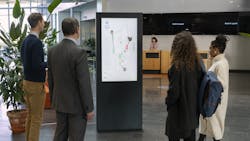Fagerhult, Sony team up for indoor positioning at commercial offices
Some people might think of lighting-based indoor navigation as a solution in search of a problem, but the industry continues to develop systems that send location and mapping information to people’s smart phones. The latest example is that Swedish lighting vendor Fagerhult has teamed with Japan’s Sony Corp. to guide people around offices, something which might be handy as the business world returns to work in pared-down property.
The new Fagerhult X Sony system makes use of motion sensors and Bluetooth beacons that Fagerhult already embeds in its office luminaires, using technology from its Organic Response (OR) unit. OR is typically used for wireless lighting control but can be harnessed with other connected lighting functions.
In Fagerhult’s new alliance, Sony is providing software including an app and a cloud connection, based on its own Nimway smart mapping system. Sony has been offering Nimway commercially since 2017 as a standalone framework including sensors and Bluetooth components independent of lighting.
The Fagerhult partnership can speed up deployment because Fagerhult’s OR-embedded luminaires already include the chips required to detect and communicate presence.
“A building equipped with Organic Response already harnesses the infrastructure to quickly deploy a Nimway solution without any major further investments,” a Fagerhult spokesperson told LEDs Magazine.
The new alliance at the moment includes just one of the Fagerhult Group lighting brands, Fagerhults Belysning AB, but could expand to others, the spokesperson said.
The two companies declined to reveal pricing or to identify any pilot customers.
While indoor positioning and other lighting-based Internet of Things (IoT) functions have been slow to catch on, they could have more of a role to play now that companies are returning to some amount of office work following a year of pandemic-related shutdowns. A hybrid office/home working scenario is shaping up, in which office spaces might shrink and more “hot desking” takes hold.
Systems such as Nimway can facilitate the new work ways not only by helping employees find their way around unfamiliar spaces but also through other means. Nimway allows users to book rooms, reserve desks, report maintenance issues — faulty coffee machines, for instance — and even figure out how much time it takes to get from one location to another on the premises. Facility managers can also use it to analyze space utilization and to subsequently make changes to office layouts.
“Tomorrow’s workplaces are in intelligent buildings, which can answer the question — what do you want to do and achieve today?” noted Andreas Tolf, Fagerhult product and application manager controls. “This requires flexible, connected premises. That’s why we’re excited about collaborating with Sony, where both lighting control and navigation really put employees’ needs in focus.”
Sony’s Lars-Gunnar Lundgren, senior business manager Nimway, had a similar take.
“There are studies showing that 33 minutes of each working day is lost when people are looking for colleagues, available rooms for meetings or the right room,” he said. “That is precisely the kind of problem we are solving with Nimway. In our collaboration with Fagerhult, we can now also add the value of adapted and individual lighting, which further increases wellbeing at the workplace.”
Sony first developed Nimway for its own internal use a decade ago to help employees find their way around a Sony research and development site in Sweden which had implemented new agile work processes involving more moving about the premises than had previously been the case.
Fagerhult has in recent years struck other technology partnerships to widen the scope of OR, working, for instance, with Finland’s wireless mesh protocol company Wirepas.
The Sony partnership marks at least the second move in a month by Fagerhult in connected lighting, IoT, and controls. In April, Fagerhult Group purchased the 80% of Danish outdoor lighting connectivity specialist Seneco that it did not already own.
MARK HALPER is a contributing editor for LEDs Magazine, and an energy, technology, and business journalist ([email protected]om).
For up-to-the-minute LED and SSL updates, why not follow us on Twitter? You’ll find curated content and commentary, as well as information on industry events, webcasts, and surveys on our LinkedIn Company Page and our Facebook page.

Mark Halper | Contributing Editor, LEDs Magazine, and Business/Energy/Technology Journalist
Mark Halper is a freelance business, technology, and science journalist who covers everything from media moguls to subatomic particles. Halper has written from locations around the world for TIME Magazine, Fortune, Forbes, the New York Times, the Financial Times, the Guardian, CBS, Wired, and many others. A US citizen living in Britain, he cut his journalism teeth cutting and pasting copy for an English-language daily newspaper in Mexico City. Halper has a BA in history from Cornell University.





